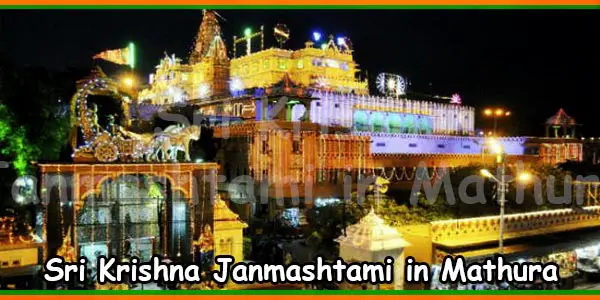Mathura, and ancient city of north India, is the birth place of Lord Krishna. Hence, maximum celebration of Janmashtami takes place here. Mathura city is about 145 km from Delhi. About 5000 years ago, Krishna was born to get rid of all evil demons. During Janmashtami, Mathura is completely decorated with festive looks with devotional mood at its pinnacle.
Here in Mathura, the main celebration occurs at Lord Krishna’s actual birth place. The same spot has been converted into main temple called Krishna Janma Bhoomi Mandir. Lord Krishna’s idol is kept in the ‘Garbha Griha’ [room]. On Janmashtami, the devotees fast for the entire day. They break their fast at midnight after the time when Bhagwan Krishna was born. Throughout the day, the devotees remain immersed in chanting Shlokas and names of Lord Krishna. The devotees also sing songs and hymns in the glory of Sri Krishna.

Midnight Celebrations:
Since Krishna was born around midnight, the auspicious moment is celebrated with pujas and other ceremonies. Lord Krishna’s idol is bathed with milk and curd. Afterwards the Lord’s idol is rocked in the cradle. The devotees believe that any wish made while rocking the cradle would be fulfilled on Janmashtami. Mathura resound the shankh [conch] and ringing of bells. The devotees pray and welcome the Lord Krishna with slogans of ‘Jai Shri Krishna’. The devotees perform prayers. The Panchamrit that is a mixture of honey, Gangajal, curd, milk, and ghee is distributed. Lord Krishna is fed with customary prasad of ‘Chhapan Bhog’ [Fifty six dishes]. The devotees break their fast with the ‘prasad’ of Lord Krishna. The devotees enjoy lots of eatables made of milk and milk products. Some of the main dishes prepared are Kheer, laddoo, butter, shrikhand and singhare ki poori on Janmashtami.
Performance of Rasleelas:
Rasleelas are dance dramas that are performed at various places in Mathura. Both professionals and amateurs stage and enact these Rasleelas. These are performed by young boys between ages 10-13 years. The boy enacting Krishna becomes divine form to devotees who touch his feet in reverence.
Jhanki [Tableau]:
Jhankis are cribs or scenes depicting various stages of Lord Krishna’s life. These tableaus are commonly seen during Janmashtami all over Mathura city. The jhankis depict various important events and deeds of Lord Krishna’s childhood. Most popular Jhankis are Janmlila, Shankarlila, Putanalila and Naglila.

Jhulanotsav and Ghatas:
In Mathura, during Janmashtami other important features include Jhulanotsav and Ghatas. Both are special festivities of Mathura. Jhulanotsav festival is marked by placing swings in the courtyard of temples and houses. This is done in order to welcome Lord Krishna’s birth ceremony. Jhulans [swings] symbolise cradling of Lord Krishna so ropes of the jhulans are decorated with flowers.
During Janmashtami, month-long unique feature known as Ghatas is popular for decorating all temples in Mathura. A particular colour is selected for using the theme for Ghatas. Even Lord Krishna’s idol is adorned with clothes having the same colour. The devotees put their heart and soul to decorate all Lord Krishna’s temples. Also they decorate their own homes. Thus, all the devotees welcome the birth of Lord Krishna.
Number of Visitors during Janmashtami:
During Janmashtami, an estimate of 8 lakhs of devotees visits Mathura, the birth city. In addition, this number is growing every single year. Visitors around this time of the year have difficulties finding accommodation. Hence, most devotees get prior reservations made. There are very long queues at all the temples. Maintaining law and order is very challenging for the security guards.
